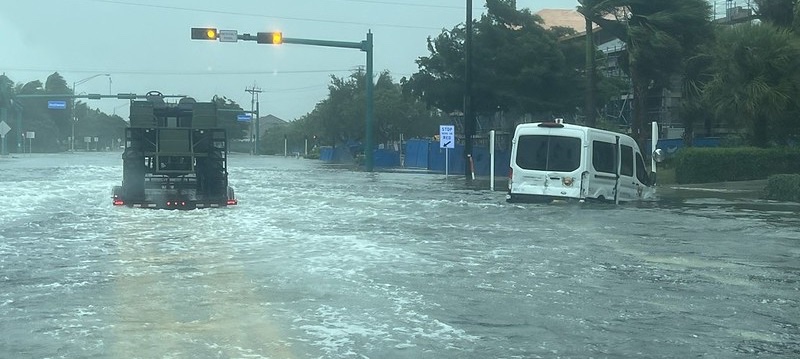Businesses Brace for Safety
Florida Fish and Wildlife Law Enforcement
Water floods the urban street while wind roars through palm trees Photo was taken on Sept. 28 when Hurricane Ian made direct landfall over Florida
70 billion dollars. That is the total amount of monetary damage Hurricane Ian has dealt. This staggering loss makes it the most expensive storm to ever hit Florida.
Ian made landfall as a category 4 hurricane on Sept. 28 with 150 mph winds. The vicious storm propelled waves from the Gulf of Mexico to crash into the western shore of the state. The Fort Myers area including Naples and Key West were the hardest hit with flooding levels as high as 7.2 feet.
There are struggles to owning a business in general but with the fear of tropical storms, it’s even harder. Adrian Pivetta owns a computer repair and data recovery business in Sunrise Florida near Fort Lauderdale.
“When I opened my business 10 years ago, I installed special glass in the front of the shop that is virtually unbreakable,” Pivetta said. “It’s called polycarbonate and is like a rubberized glass so that installation automatically gave us hurricane preparedness.”
This extra precaution proved useful because since 2012, there have been three notable hurricanes that have hit the state of Florida. They include Ian, Irma and Michael which was a category five hurricane. A category five is the highest classification with winds swarming to at least 157 mph. To put in perspective how destructive Ian was, the storm was only seven mph from being classified as the highest category hurricane.
Luckily, Pivetta’s shop was located out of the direct path of Hurricane Ian. Over his 20 years of residency in Florida, there have been many precautions the state implemented in anticipation of these storms. The biggest change was putting power lines underground.
Although more underground power lines were in place, more than 2.5 million people were left without power as Ian rampaged through the state. Luckily, 2 million of those customers’ power was restored in five days or less.
It can sometimes be hard to understand the true destructiveness of these storms. 70 billion dollars in itself is a near incomprehensible number to imagine.
“I remember hurricanes in 2005 to 2007 where they were much more impactful in my area of South Florida,” Pivetta said. “I was located directly in the path of the eye of the storm so it went right through the community. The aftermath of the storm was so disastrous, I remember driving through the streets the morning after, and there were trees that had fallen down all over the roads.”
The northern states aren’t vulnerable to massive ocean waves and extreme flooding. However, a large snowstorm has many similarities to the aspects of a hurricane. Neighbors look out for each other, people have to be careful driving; although the threats are so different, there are many commonalities between these types of natural disasters. In a colossal snow storm power outages can occur, roofs can cave in and many other accidents tie into the mass amounts of property that can be damaged.
Hurricane Katrina in 2005 was the deadliest hurricane to hit the United States in the 21st century. Ian compares by ranking second just behind Katrina in terms of damaged property. The damage has been dealt and for business owners like Adrian, all that’s left for them to do is prepare for the next storm.









